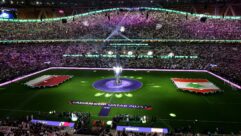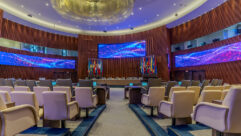An International Landmark: Hong Kong has long been a strategic location forinter-Asian trade and is increasingly seen as the focal point for the fastexpanding China trade.
Nov 1, 1997 12:00 PM,
Ward Sellars
The Hong Kong Government is aware of the growing competition from regionalrivals such as Singapore and Malaysia, Southern Chinese cities such asGuangzhou (Canton) and Xiamen (Amoy), and even from Greater China citiessuch as Taipei and Shanghai. The response to this growing trade competitionhas meant that Hong Kong has been aggressively promoting and buildingdevelopments that enhance trade efficiencies – container terminals,airports, sea ports, highways and bridges, including the worlds longestroad-rail suspension bridge, high speed rail connections and a multi-vendortelecommunications environment.
Because Hong Kong’s life-blood is import and export, trade fairs andlarge-scale conventions are a cost-effective means of business promotion.Since the Hong Kong Convention and Exhibition Centre facilities opened in1989, the Hong Kong business community has enthusiastically embracedlarge-scale trade fairs, such that the present facilities located atHarbour Road have reached saturation point. In 1993, the government decidedto expand the convention center by building an extension, which would jutout into the harbor on reclaimed land. The extension, which would be builtfrom government funding, would cost $4.8 billion in Hong Kong currency($620 million U.S. currency).
Considering its prominent location, surrounded on three sides by the harborand visible from almost all points of the major business and tourist areas,the government decided that the extension had to be a landmark building.When people try to visualize Hong Kong, they should see the conventioncenter much in the way that the Sydney Opera House, the Eiffel Tower or theEmpire State Building are inextricably linked with their respective cities.The Hong Kong Trade Development Council (TDC), a government body, is theowner of the building complex. Dr. Victor Fung, chairman of the TDC, wantedthe new building to be an evocative symbol of Hong Kong’s dynamic economy,its optimism about the future, and its new role as a gateway to China. Inaddition, the extension needed to link seamlessly into the existingbuilding so that the two buildings could be operated as a single integratedcomplex. The combined facility would become the second largest exhibitioncenter in Asia, after the Tokyo Exhibition Centre.
Fung got his wish. The new extension is architecturally magnificent, bothuplifting and optimistic. Its design evokes flight so that it resembles agreat silver bird, and its curving glass surfaces reflect the harborinternational boat traffic, giving full visualization and historicalreferences to the meaning of the phrase “Hong Kong – Gateway of theOrient.” Its orientation toward the North is toward China; Hong Kong’sfuture rests with the mainland.
After an international design competition, which included many big namessuch as I.M. Pei, Norman Foster and Cesar Pelli, the TDC selected localarchitect Wong & Ouyang (W&O) as the lead consultant in conjunction withChicago-based architects Skidmore Owings & Merrill (SOM). Wong & Ouyangwere selected not only because of the company’s integrated A/E experience,but also because of its pioneering design concepts and willingness to pushthe technology envelope to the limits. SOM was selected as the partner forW&O primarily because of the company’s world-famous expertise in steelstructures and unusual cladding design. Larry Oltmans of SOM and W.H. Lamof W&O were the two principal designers for the building.
Starting in October 1993, the two architectural firms started a series ofarchitectural concept studies, which eventually resulted in six detailedplans. In November 1993, W&O commissioned the local Hong Kong office ofShen Milsom & Wilke to undertake conceptual design for the acoustics,audiovisual and telecommunications systems for the building. By February1994, Wong and Ouyang were appointed to perform detailed design work basedon a joint W&O/SOM accepted design, and Shen Milsom & Wilke were retainedas a sub-consultant to W&O for the acoustics, audiovisual andtelecommunications design. During 1994 and 1995, the design team preparedthe contract documents for the telecommunications and audiovisual systems.These were tendered out in January 1996. The audiovisual system tender wasawarded to Audio Consultants Company Ltd., a subsidiary of EVI (Mark IV atthe time). The SMATV system installation went to a nominated subcontractor,Digital Precision Asia Ltd. The telecommunications tender was awarded toJardine Office Systems (JOS), which included a large Nortel Meridian PABXand a Lucent structured cabling system.
Construction of the buildingThe HKCEC extension became a constructional tour de force, needing toovercome three major challenges: the difficult site, the structural andengineering complexity of the massive project, and the inflexible June 30,1997 deadline, a totalof only 3 1/2 years from the start of design.
The general contractor team of Hip Hing/Dragages Joint Venture was given amammoth undertaking to accomplish. They first needed to create a 6.5hectare island for the building, using more than 31,788,000 ft cubed(900,000 meter cubed) of landfill. This was accomplished in just sixmonths, using round-the-clock dredging and reclamation equipment that wasalready in Hong Kong for the construction of the new airport. Even beforethe reclamation was finished, more than 3,000 piles were driven 116 feet(35 m) into the bedrock below the island.
The construction team could not wait for the reclamation to settle beforeconstruction, so the building literally sits on top of the piles like apier, with the reclamation able to sink around the building withoutaffecting its integrity. Immediately after the piles were completed, thefoundations were started on top of the piles. The total building eventuallyused more than 6,357,600 ft cubed (180,000 meter cubed) of concrete and13,605 tons (15,000 tonnes) of structural steel. The major architecturalfeature of the building, its complex curved roof structure, entailed thedesign and construction of truss frames that were 265 feet (80 m) long andeach weighed more than 453 tons (500 tons). These were so big that therewas no place in Hong Kong large enough to fabricate them. They wereeventually built in Batangas, 600 miles (968 km) to the south in thePhilippines and brought to Hong Kong on enormous ocean-going barges.
FacilitiesThe final design envisioned a total of 186,000 yd squared (155,000 metersquared) over six levels and is linked to the existing building through abridge that spans a stretch of harbor water and a future eight-lanehighway. This bridge, called the atrium link, is a major engineering feet,spanning a clear 298 feet (90 m) and formed by steel trusses that are 89feet (27 m) high. The atrium link contains three layers of walkways thatlink the existing and new buildings. All of the interconnecting cabling andservices between the two buildings are also housed there.
The scale of the building is vast with extremely large-volume interiorspaces. The Grand Hall at Level 5 seats more than 4,500 people forconference events and more than 3,600 people for banqueting. The ceiling ofthe Grand Hall is more than 93 feet (28 m) from the floor and is almost 232feet (70 m) long by 165 feet (50 m) wide. In the Grand Hall foyer, a 132foot (40 m) high curved glass wall looks out over the harbor.
These large-volume spaces represent a considerable acoustical challenge inreducing long reverberation times and in providing excellent voiceintelligibility. The Grand Foyer, in particular, demanded an audioreproduction solution that did not excite the entire volume of space or the132 foot (40 m) high parabolic glass wall. The Grand Hall volume was suchthat reverberation times could not be reduced below 2.5 seconds, so audioreproduction needed to be focused on the audience area on the floor. TheGrand Hall needed video and data projection large enough so that everyonecould see. Multiple video cameras with long zoom lenses and precisionpan-tilt heads were needed so that all parts of the hall could be picked upand reproduced. This was especially important for the simultaneousinterpretation translators, who needed to see the faces of all those whowere speaking in the hall. Without the cameras, faces 232 feet (70 m) awaywere simply unrecognizable.
The exhibition halls were large-volume spaces that demanded flexibility andhigh-performance audio reproduction, so as to meet fire requirements thatemergency announcements must be at least 10 dB above the ambient backgroundnoise. Measurements made in the existing center during some noisy consumerelectronics exhibitions indicated that sound pressure levels in thecorridors between the booths could easily exceed 85 dBA; on a number ofoccasions, SPLs were higher than 90 dB. Therefore, the sound system had tobe able to achieve more than 100 dB at the entire floor level of the exhibit halls with headroom to spare.Because loudspeakers were located 36 feet (11 m) above the floor and the room presented a difficult reverberantatmosphere, pattern control was a prime consideration. Ambient noisesensing was deemed essential to providing the automatic ambient monitoringand correction of reproduction levels accordingly. Experience in a previousproject at the Royal Hong Kong Jockey Club racetrack had proved that thissystem would be reliable and effective.
Hall 3, at Level 7, is one of the largest column-free halls in Asia with afloor plate of 10,200 yd squared (8,500 meter squared) and a ceiling heightaveraging 50 feet (15 m), rising to 60 feet (18 m) in the center. This hallis earmarked for large pop concert and other popular audience-basedattractions, such as Disney on Ice or badminton, volleyball and boxingmatches.
A major acoustical challenge for this area and for the adjacent Grand Hallwas the lightweight curved roof. The curved roof structure acts as anaerofoil in a high wind, and during the local typhoon season, the roof willwant to fly away. This means that the roof must be able to rise up and downa total of 4 inches (100 mm). All demising walls, even those earmarked forhigh acoustical separation, had to have complex telescopic joints thatcould accommodate this roof movement.
Another major issue with the roof was noise from falling rain. The roof isessentially a lightweight tin roof, and therefore, it is susceptible todrumming from the local tropical rain. (Hong Kong receives 120 inches or302 cm per year.) Although the acoustical staff designed in specialdampening materials, full-size rain noise mock-up tests of the roof wereperformed in a facility in Salford, near Manchester, England. This is theonly acoustical lab in the world large enough to do such large-scalemock-up tests.
High ceilings and voids in other areas, such as the atrium link, demandedmodest audio levels but high intelligibility, so voice bandwidth deviceswere specified and arranged so as to generate maximum intelligibility.
A suite of meeting rooms, both large and small, on the second and thirdfloors had to be closely interconnected with one another and able toparticipate in audio and video relay from other parts of the building orfrom outside the complex. These rooms needed not only to have the latest invideo and audio reproduction capabilities, but they also had to beaesthetically equivalent to hotel ballroom and meeting facilities.
A series of restaurants required high-quality audio reproduction, which wasunder the control of the local managers but could be overridden by centralemergency paging announcements.
A large administrative office needed to have a high-tech boardroom suitablefor presentations to 30 people. Loading docks, which can be used bynumerous 40 foot (12 m) container trucks and full-size outside broadcastvehicles, required clean three-phase power, fiber-optic links, audio andvideo tie-lines and intercom connections. Three positions for OB truckswere provided with a large complement of audio and video tie-lines, bothcopper and fiber.
Even the kitchen communications had to be high-tech. The center houses oneof Asia’s largest kitchens, capable of preparing meals for 4,000 people atone sitting. Chinese cuisine needs to be served hot and fresh withtypically less than five minutes from the time it leaves the wok to thetime it arrives at a patron’s table. Serving 4,000 people in this manner isa tall order. It could be achieved only by outfitting the catering captainwith a wireless intercom and building eight plating stations equipped withhands-free intercoms. In this way commands could be relayed from the floordirectly to the catering staff arrayed around the perimeter of the GrandHall.
Last, the center needed a first-class satellite master antenna TV systemwith an entire internal broadcast capability, multilingual (Chinese,English, Japanese and European languages) caption generation and graphicsinsertion, stereo audio channels and a minimum of 12 satellite channels inaddition to the four terrestrial channels and 16 terrestrial cable channels.
Acoustics, audiovisual and telecommunications designIt is not often that these three disciplines fall under one integrateddesign team. Shen Milsom & Wilke drew upon its resources at its office inHong Kong, led by the author, and from its head office in New York, wheredesign team members in all three disciplines were coordinated under thedirection of Fred Shen, president. In particular, Eric Rochelson, PeterBerry and Walter Lam contributed significantly to the audio and videodesign concepts; Bob Eastman, Jeff Conley and Terry Ng preparedtelecommunications design documentation; and Ben Houghton, Francis Danieland F.K. Wong contributed immensely to the myriad of acoustical issues thatwere a by-product of the novel architecture of the building. Because SM&Wwas working under Wong & Ouyang’s direction, regular and intensive designcoordination meetings were planned with the architect starting from thebeginning of the conceptual design stage at the end of 1993.
A/V and telecom shared mediaIn late 1993, the Hong Kong and New York design teams began to assesswhether it was feasible and possible to replace most traditional audio andvideo cable and routing/switching with a generic cable-plant made up ofcategory 5 unshielded twisted pair copper wire and fiber-optic cable asdescribed in detail in EIA/TIA 568A and ISO/IEC 11801. These media and theinfrastructure to support them were being implemented as part of thetelecommunications systems for the new building. In particular, the telecomdesign was being put together in such a manner as to make no distinctionbetween voice, data and video applications. All applications would shareone generic cable network arranged in a physical star configuration. No UTPoutlet would be more than 298 feet (90 m) from an associated intermediatedistribution frame, as per the TIA 568A standard.
This requirement was a difficult one to reconcile, considering the enormousdistances across the floors of the exhibition halls, and it did influencethe decision of the architect to construct a subway tunnel under eachexhibition hall. This tunnel ensured that telecom and audiovisual roomscould be constructed there and still meet the 298 foot (90 m) rule. In theend, more than 5,500 CAT-5 UTP outlets and more than 1,100 fiber-opticoutlets were installed throughout the building. The center ended up with atotal of 27 telecom and A-V distribution rooms.
The telecom and data infrastructure was designed to accommodate audio andvideo services by any variety of protocols over a robust and flexible starnetwork. Space was allocated for routers, hubs and switchers, andsingle-mode and multimode fiber were specified in quantities to support themost extreme networks imaginable, with bandwidths up to 20 Gbps.
So, why not put all of the audio and video onto this future-proof network?This single question occupied the design team during early 1994. Manymanufacturers were contacted, including names familiar to the telecomworld, such as Alcatel, Fujitsu, AT&T (now Lucent), Nortel and Siemens.Other companies more familiar to the readers of this magazine, such asCrown, QSC, IED, Peavey/Peak Audio, Rane, GVG, Sony and others, werecontacted about real hardware available for CAT-5 UTP/Fiber distribution.Most of them reported that they were studying the recently published TIA568A standards and that they were contemplating engineering products thatcould operate in a networked environment. None of them could claim tohaving such products ready at that time, and very few predicted that theirproducts would be ready – and mature – in order to be specified by theDecember 1995 deadline. CobraNet was in the very early stages ofdevelopment at that time, and although very promising, we didn’t want tobet on a technology that had no licensed manufacturers at that time (1994).
So the decision was made that the audio and video systems would beconstructed with traditional audio and video cabling in a point-to-pointconfiguration. However, all audio and video distribution hardware andpatchbays would be co-located with the UTP/Fiber patch frames of thetelecom system. This would allow the phased implementation of networkedaudio and video over the UTP/Fiber cable plant as and when the electronicswere actually available from the manufacturers.
Audio systems in the extensionAfter much internal discussion and study, the design team decided thatthere would be a central digital router/processor that handled every bit ofaudio in the new building, except for the Grand Hall audio (ConventionHall). It was also decided that there needed to be a monitoring and testsystem that would interrogate all of the Audio system for faults on acontinuous basis.
The Grand Hall is essentially a large theater, and therefore, it made senseto have a powerful, but traditional digitally controlled analog audiosystem in this area, complete with a large audio mixing board, main anddelay loudspeaker clusters, and numerous outboard audio devices. There aresubstantial digital components in the Grand Hall audio system, such as thetwo-in four-out DSP engines, but these are used to replace traditionalanalog devices. The Grand Hall audio system has emergency life safetypaging override from the central digital router, and there are programoutputs from the Grand Hall to the central digital router. The Grand Hallhas a large loudspeaker cluster directly above the stage, which isprimarily used for voice. There are also smaller clusters on the right- andleft-hand sides of the stage, which are primarily used for musicreproduction or for film or video multichannel reproduction. Because of thesize of the room, there are also six sets of delay clusters at the left andright sides of the hall covering the extreme rear and corners of the room.The main loudspeakers are recessed behind facia and are consequentlyinvisible to the patrons. Two large subwoofers are located within thestage. Also in the stage are located seven near-stage fill loudspeakers inorder to cover the first six to 10 rows of patrons. The loudspeakers inthis hall are fed from a total of 32 amplifiers with a combined capacity of44,000 W. Coverage is uniform throughout the hall with all speakersactivated.
The Grand Hall Foyer (Grand Foyer), required special consideration due toits enormous volume and 132 foot (40 m) high parabolic glass walls. It wasessential that we did not excite the glass, which would have resulted inserious focusing problems. The design team selected small, high-poweredloudspeaker units with controlled dispersion to be mounted on architecturalspandrels some 23 feet (7 m) off the floor, at the window line, facing downinto the floor area. This gets the audio to people’s ears, but not anywhereelse. The focusing problem was overcome, and excitation of the entirevolume was eliminated.
The rest of the building, including all of the paging stations, all of themeeting rooms, exhibition halls, administrative offices, loading docks,workshops, kitchens, storerooms and circulation areas, are managed throughthe central digital router that is located in the head end room. In manycases, this means that signals transfer a distance of 2,315 feet to 3,307feet (700 m to 1,000 m) from the microphone or line input to the finalloudspeaker destination. By keeping the line driver impedances low, we areable to achieve transmission of balanced audio over these distances that isflat within 3 dB from 20 kHz to 20kHz and with only 0.25 dB of broadbandattenuation over the longest copper cables. For the very long cable runsbetween the Grand Hall control room and the existing building, whichexceeds 4,960 feet (1,500 m), we depend entirely on fiber-optic tie-linesfor both audio and video signals with six video and 12 audio in eachdirection. If a particular user needs to have more video or audio in aparticular direction, then the receivers and transmitters are swapped, andthe configuration becomes 12 video and 24 audio in one direction.
An announcement control system front-end performs the management of the 56paging microphone inputs. This system also contains the digitalrecord/player and permanent digital record player, which are treated justlike paging station inputs. The Telephone inputs are also connected to theannouncement control system just like other paging stations. Up to eightpaging station outputs simultaneously can be fed to the digital router,which also performs all of the mixing, equalization and delay for each ofthe output zones. The router is configured to mix up to six sources at eachof the digital crosspoints dynamically. In this way, we can do ducking andcross fading between sources.
The output zone assignments are set up using a graphical user interfacethat includes a complete map of the facility for each level. Eachinput/output zone mapping is assigned a scene name, and these are recalledfrom the paging stations or from central control computer located in thehead end room. A total of 64 line-level audio inputs feed the centraldigital router. These include six different background music sources, feedsfrom the existing building’s paging system, SMATV system audio inputs, theeight paging station ACS outputs, and, of course, all of the programoutputs from each of the functional areas, such as the meeting rooms andexhibition halls.
Each meeting room and exhibition hall has numerous microphone andline-level inputs, which are handled by a modular computer-controlledautomatic mixing system. These card-frame systems communicate over anRS-422 link to the central control computer, which provides information tothe card-frames on their room-combining status. The location of theautomatic mixers was chosen to be within 661 feet (200 m ) of anymicrophone input. This means that there are microphone mixers scatteredover the facility in seven different locations, always co-located withtelecom data/voice UTP and fiber patching and with other audio monitoringand distribution hardware. The microphone inputs have a programmable gaincontrol that controls feedback on a single input basis and adjustssensitivity individually. This is important for the kind ofnon-operator-assisted plug-and-use functionality that was deemed importantto this venue. The line-level inputs have VCAs fitted with a small levelcontrol pot at each faceplate for locally controlling the signal level tothe central digital router. In the suite of 26 meeting rooms spread overtwo floors, a digital control system is fitted in each meeting room with acontrol frame located on each floor. These control panels select anavailable background music source (from four) or a local line-level inputspecific to that room and adjust the program output level for that room.These control panels and frames talk to the central control computer andinitiate input/output maps that have been previously set up as scenes.
The floors of the exhibit halls needed to be handled in a special way, aswe could not install permanent faceplates there. The design team came upwith a break-out box concept that provides all of the audio and controlcapability in one small box connected to a multi-core snake. These boxescontained multiple microphone and line inputs (line inputs with pots) andline outputs (press feeds equipped with compressor-limiters). The box alsocontained two LED lights. One indicates that the box is active, meaningthat it is plugged into the rack in the sub-way below the floor. Anotherlight indicates whether the volume control on the break-out box is activeor not. This light is controlled by the central control computer.
The default control of audio level in the exhibit halls is by the ambientnoise sensing system. The break-out box contains a slider level controlthat communicates to the central control computer over a serial link. Thislevel control is normally disabled. Once the break-out box is installed ina particular location and the user requests local manual level control, thecentral computer then assigns that level control to the output zone map,and the indicator light on the break-out box lights up, indicating that thelocal level control is active. This local level control function is alsoduplicated on permanently wall-mounted faceplates in the exhibit halls.
Audio monitoring equipmentis also located in each of the sevenamplifier/mixer/distribution rooms is also located . This comprises aself-powered rack mount loudspeaker and a 1/3-octave audio analyzer, whichalso contains a precision level indicator and pink noise source. Balancedaudio patchbays are wired half-normal (listen/cut) for all line-levelsignals and full normal sleeves brought out for all microphone-levelsignals. Loudspeaker patchbays are constructed using Speakon connectors.There is also a multicore patchbay where 37-pin and 56-pin MS connectorsare cross-connected or are broken-out to the GPO patchbays for individualcircuit applications.
A four-circuit party-line intercom is included to every equipment room andto numerous wall-plate outlets around the building, for a total of almost100 intercom outlets.
Video systems in the extensionThe SMATV system is a cable TV broadcast facility. Programs can beoriginated in the center and broadcast over the SMATV system in a varietyof languages. The two caption generator units are fully equipped withChinese characters so that both simplified and traditional Chinesecharacters can be interspersed with English. There are data links to thepremises management system so that messages can be passed from thereservations or message center and streamed through the charactergenerators to available SMATV channels for broadcast throughout thefacility. Three steerable satellite dishes are provided with space andinfrastructure for up to 27 additional dishes. The system also supportsreturn video on two channels. Both PAL and NTSC modulators are employed,and both are broadcast over the cable plant simultaneously to be picked upby multi-standard receivers, which are very common in Hong Kong.
The Grand Hall has a complete video production system comprised of a Visionmixer, waveform and vector-scopes, SPG, character generator, four camerason pan-tilt heads and numerous VTR sources all in PAL system. In addition,the Grand Hall has RGBS data graphics switching and distribution capabilityfor high-resolution computer graphics display. The main display is a pairof Hughes/JVC 335G Video/Data projectors superimposed onto a 92.4 ydsquared (77 meter squared) flying frame screen mounted at the stage some 70m (232 feet) from the projectors. A screen illumination close to 50candelas per square meter (60 candelas per square yard) is achieved, whichis in line with relevant SMPTE guidelines.
Fiber and copper coaxial tie-lines link all of the functional spaces withthe head end room, which, in turn, is linked by fiber tie-lines andtransmitters/receivers to the existing building’s security control room andcentral equipment rooms.
The loading docks at Levels 2, 5, and 7 are capable of handling multiple 40foot (12 m) container trucks simultaneously, and these trucks can driveright onto the exhibit hall floors. Three locations were identified aslikely outside broadcast vehicle parking bays. These are outfitted withfiber (both single mode and multimode) and copper tie-lines for audio andvideo signals, as well as intercom, power and telephone/fax lines. Thereare dedicated audio and video tie-lines to a roof-top platform that isideally positioned for microwave links. All of these facilities wereextensively used during the Hong Kong Hand Over ceremonies on July 1, 1997,and were also heavily used during the IMF/World Bank Annual General Meetingin September of 1997.
Control systems in the extensionThe remote control systems in the new extension are rather modest becausethe hirers often bring their own equipment with them or rent from anoutside vendor. The control systems in the large meeting rooms are similarto those found in five-star ballrooms where there is transport and sourceselection from touchscreen and wireless control panels. However, the mainfunction of the control systems is to communicate to the central digitalrouter the status of rooms combining in the meeting rooms. Originally, thiswas intended to be automatic with sensors that determined when the wallswere in place. However, the operator decided that he would like to have amimic-panel arrangement and do this manually in the main control room nearthe meeting rooms. This room combination selection is converted to anRS-422 signal that goes to the central routing computer and calls up scenesthat both change the digital routing as well as tell the automatic mixercard frames to perform acoustical combining. The small meeting rooms havebutton panels that select background music sources or local audio inputs.
SummaryThe Hong Kong Convention & Exhibition Centre Extension was created to showoptimism about the future of the Special Administrative Region of China.The design team has taken Fung’s ideas and tried to prepare the buildingfor absolutely anything that the technology of the 21st Century can throwat it. We would like to express our gratitude to Wong & Ouyang and theTrade Development Council for being on the team .










